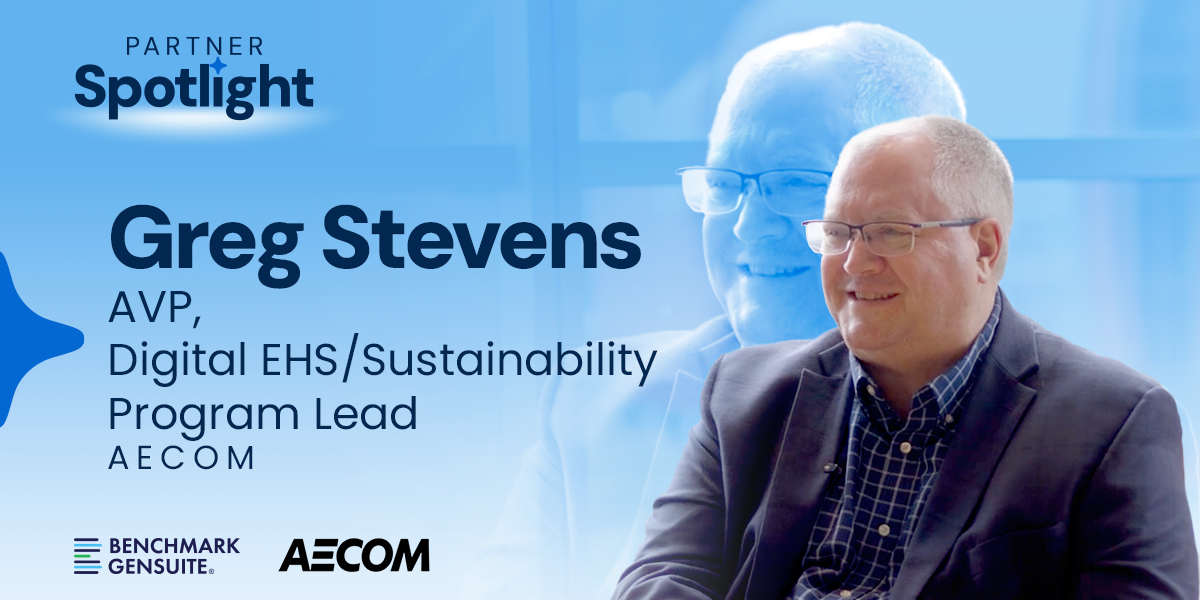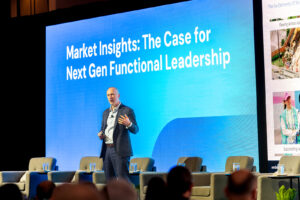Breaking Down Data Silos with a Unified EHS & Sustainability Software Across the Enterprise
In today’s complex regulatory and operational landscape, EHS and sustainability leaders are being asked to do more than ever before — measure performance, prove impact, and adapt to constant change. That’s where the right technology and partnerships make all the difference.
Greg Stevens of AECOM brings deep expertise in global EHS strategy and digital transformation. In this Q&A, Greg shares how AI and unified EHS software, combined with strategic partnerships, are redefining the EHS function, breaking silos, and empowering teams with real-time insights.
Key Takeaways
- AI is reshaping EHS — helping professionals move from collecting data to uncovering insights that drive smarter, faster decisions.
- Collaboration fuels innovation — strong relationships such as the AECOM and Benchmark Gensuite partnership help organizations connect systems, reduce inefficiencies, and elevate safety outcomes.
- Unified platforms break silos — integrating quality, maintenance, and EHS workflows gives companies a complete view of performance and compliance.
- Sustainability drives accountability — evolving ESG and ISO standards are pushing organizations to take responsibility for data accuracy, transparency, and global impact.
- Holistic thinking delivers value — AECOM’s systems-level approach enables clients to streamline operations, lower risk, and strengthen their environmental and safety culture.
What makes the AECOM and Benchmark Gensuite collaboration effective in advancing EHS and operational excellence?
Greg: It’s a relationship built on collaboration, just like the relationships we have with clients. We’re working to collaborate more closely with Benchmark Gensuite — not just to fill in gaps in workflow solutions or connect to business processes — but also to help companies more effectively use the Benchmark platform, especially larger multinational clients that might not be integrating it into their business as fully as they could.
We love doing that and seeing where companies can better utilize the entire platform. Many organizations have invested in different siloed applications over the years — maybe they have Benchmark, but also separate tools for quality, management of change, contractor management, or maintenance management — and none of them work together fluidly.
The EHS professional needs all those systems to work together. They might send a task into a maintenance management system and not know when that task is completed — it just takes time out of their day. We love that we can help companies be more efficient, maybe get home earlier, and obviously get home safely and in one piece. That’s what this whole solution and community are about: getting people home safely, understanding the impact they’re having on the planet, and reducing it. We’re all in that game together.
What cutting-edge technologies are most exciting in EHS right now, and where do you see the biggest potential?
Greg: Clearly the AI aspect is very interesting to see where that’s leading. I don’t think we really appreciate or understand where it’s actually leading in EHS. We’re still combining some of our traditional approaches and then adding some AI — to make our responses better, help prompt us to fill out forms more efficiently and completely, and bring more timely insight into the data that’s already there. But beyond that, I think there’s a lot more to explore. I’m pretty excited about that.
Discover where the future of EHS is heading: Meet our AI Agents and learn how they are integrated into our unified software.
What are some of the key drivers behind the emergence of AI in the EHS and sustainability industry?
Greg: There are a few things driving AI, and one of them is ESG and sustainability — they’re asking questions companies haven’t been asked before. They’re being asked for numbers: performance numbers, environmental and carbon data.
Traditionally, regulations focused on sites — what’s inside your fence line, what permits you need, whether you’re in compliance at a facility. But now companies are being asked questions about the entire company.
They’ve had sustainability reports, but those were mostly voluntary. Now, when you’re talking about data that impacts the company fiscally or from an investment standpoint, you have to get serious about those numbers. That means having the ability to roll up data from all your locations and facilities.
Another big driver is globalization. The net is being cast much wider. You’ve heard the terms “farm to fork” and “cradle to grave.” We’re seeing this in EHS when you talk about Carbon Scope 3 — expanding that net beyond operations, both upstream and downstream.
What are your suppliers doing? What’s their carbon footprint? Let’s throw that in, so smaller organizations are also accounted for in the total carbon impact.
We’re also seeing global harmonization of ISO. The former ISO requirements said executives needed to have awareness. Now, ISO is requiring executives to be responsible. That’s a very important change — from awareness to responsibility.
These are global standards, not a U.S. or Canada or Europe thing — they’re industry standards. You saw it happen in food safety, and now it’s happening in EHS and sustainability: What are your suppliers doing? What happens to the lifecycle of your product when it goes into a landfill?
The whole net is being cast wider — another reason to have broad platforms that can track all of that, bring it together, and protect your company’s brand.
Understand the key drivers behind AI adoption in EHS and sustainability—read the Verdantix AI Pacesetter Report.
How does AI help EHS professionals address new expectations and pressures?
Greg: You’ve got a lot of data out there — a lot of different, disparate databases. Maybe you’ve created a data warehouse or data lakes, but you still need insight and the quick ability to roll up information so you can answer questions, sometimes on a weekly or monthly basis.
AI can help you mine that data, look for correlations you didn’t see before, summarize those company-wide numbers, and then review them. You’ve got to build guardrails and reviews to make sure you’re pulling together accurate data.
I’m excited about what that brings to the EHS professional. Sustainability and ESG are helping elevate EHS to the C-suite — the data has to be defendable; it has to be auditable. It’s giving us more challenges, but it’s also elevating the game so that EHS teams can have more resources to do what they need to do.
You attended the Benchmark Gensuite Impact Conference in Nashville — what resonated most with you about the discussions on AI and digital transformation?
Greg: I thought it was admirable that Mukund, the CEO of Benchmark, gave a demo in his keynote. I don’t see that anywhere else. I see that as a very positive thing because people are there to see what’s coming in technology and in the world of AI. To just hit it right off and say, “I’m the CEO, I’m passionate about this, here’s what I’m excited about,” and then demo it — that was a very cool, exciting, and admirable thing to see. I think that speaks a lot to the community and to the partners — that this passion is real and that you see it right out of the gate.
Read about Mukund’s opening keynote at IMPACT 2025 and learn how AI is shaping the next era of EHS leadership.
How does AECOM help organizations integrate Benchmark Gensuite with their broader business systems to drive efficiency and value?
Greg: It’s all part of a big ecosystem. Companies have multiple swim lanes and business units, and sometimes they even try to put Benchmark Gensuite in a silo or two.
What AECOM does really well is look at everything holistically — the environment, health, safety, and risk — from an infrastructure and total cost of ownership standpoint. Then we look for opportunities to drive out cost and risk by integrating multiple applications, like maintenance or permit-to-work solutions.
Benchmark typically exists within a platform of solutions — business systems, accounting, purchasing, EHS. We look at all of that together and make it work more efficiently. That brings much more value to the Benchmark community and to the EHS organization. Having a partner who understands that interoperability and how it fits into the fabric of enterprise applications is key.
Final Reflections: Driving Integrated, Data-Driven EHS and Sustainability Programs with Unified Software
Greg Stevens’s insights show that the future of EHS and sustainability leadership extends far beyond compliance tracking. The right technology, paired with a collaborative partner, can unify data across sites, systems, and business units — turning fragmented information into actionable insights.
By embracing AI, organizations can analyze vast datasets, uncover hidden trends, and respond quickly to evolving requirements. Greg’s experience demonstrates that strategic partnerships and a holistic approach are essential for navigating these complexities — helping organizations achieve greater efficiency, reduce risk, and maintain compliance.
About the AECOM and Benchmark Gensuite Partnership
AECOM and Benchmark Gensuite have built a trusted partnership founded on collaboration, integration, and shared innovation. Together, they help global organizations connect environmental, health, and safety programs with digital technology that drives performance and compliance.
AECOM’s deep expertise in EHS and sustainability strategy, combined with Benchmark Gensuite’s unified software platform, empowers clients to streamline workflows, break down data silos, and achieve measurable sustainability results — safely, efficiently, and with purpose.

